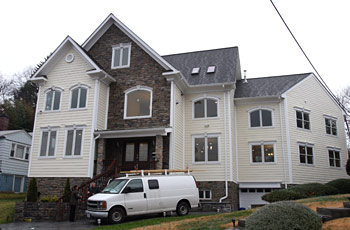New proof that green building verges on being total bull****

The 6,500-square-foot house that Jerry Zayets has constructed in the District uses energy-efficient products. (By Susan Biddle -- The Washington Post). Question: but how many people live there? And could you accommodate more houses on the same amount of land, especially if they are attached rowhouses, thereby accommodating more people, and being able to include affordable housing?
The U.S. consumes a disproportionate amount of the world's resources, in terms of per capita use. Now I don't know how much our country uses of all the world's resources, and historically the country has possessed a goodly amount of the natural resources we used. But I do know that the U.S. has about 6% of the world's population, and uses about 25% of the world's oil supply.
I am not a moral philosopher (Rawls, etc.) or too conversant with the literature but it's likely that a sustainable land use and resource planning paradigm would mean that the U.S. would, overall, consume a total amount of resources that is more in balance with the world's population. (Of course, another way to calculate the "acceptable" proportion of resource use would be to measure it according to national economic output, but there is no question that this would "privilege" the U.S.)
So we likely have to start consuming fewer resources. Therefore, the article in the Post real estate section about building GreenMcMansions, "Can Big Be Green?," is pretty funny.
Clearly the people at the Natural Resources Defense Council need some deeper learning in the subject, and I am unlikely to ever join, given their lack of deep thinking on the subject. From the article:
The two concepts of "green" and "big" hardly seem compatible. After all, green is synonymous with conservation. Big is closely linked with waste. Yet some eco-friendly homes these days are not just big, they're huge, and the relationship between size and greenness is not as clear-cut as one might think.
All else being equal, a small home is more eco-friendly than a big one. It eats up less in raw materials, emits less greenhouse gas and is more energy-efficient simply because it's smaller.
But who is to judge how much space a person needs, asked David B. Goldstein, energy program director at the Natural Resources Defense Council, an environmental group. If one 10,000-square-foot house owned by a family of four is "a bad thing," what about two 5,000-square-foot houses owned by the same family?
It's not a matter of value-neutral or relativistic thinking. I would refer people to Kohlberg and the highest moral reasoning stage of "Universal-Ethical-Humanism" or William Perry's cognitive and affective development theory and the stage of "commitment in relativism."
Now these are world figures, but they make judging easier than Mr. Goldstein seems to believe:
… Inequalities in consumption are stark. Globally, the 20% of the world’s people in the highest-income countries account for 86% of total private consumption expenditures — the poorest 20% a minuscule 1.3%. More specifically, the richest fifth:
- Consume 45% of all meat and fish, the poorest fifth 5%
- Consume 58% of total energy, the poorest fifth less than 4%
- Have 74% of all telephone lines, the poorest fifth 1.5%
- Consume 84% of all paper, the poorest fifth 1.1%
- Own 87% of the world’s vehicle fleet, the poorest fifth less than 1%
From Behind Consumption and Consumerism - Global Issues. Also see the AAAS Atlas of Population and Environment. And "Is Ethanol for Everybody?" from the New York Times. From the article:
Danuza, round-faced and soft-eyed, makes between $8 and $13 a day depending on her productivity. At 35, she has four young children. Only 20 percent of the 7.5 million acres planted with sugar cane in Brazil is mechanized. The rest depends on manual labor like hers....
If the vast potential of sugar cane ethanol is to be realized, in Brazil as in poor African countries, its development must come in ordered ways that allow the likes of Danuza and her children to benefit. A new fuel should not carry oil’s frequent curse: the enrichment of a narrow elite.
This will depend on several things: the labor standards adopted by the growing hordes of international investors drawn to ethanol; the opening up of the global trading system to this biofuel that many poor tropical countries will be able to produce; and the development of a global traded commodity market in ethanol with established norms.
Labels: energy, environment, sustainable land use and resource planning



0 Comments:
Post a Comment
<< Home